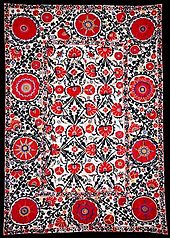- Suzani textile
-
 Bokhara suzani with pomegranate design.
Bokhara suzani with pomegranate design.
Suzani is a type of embroidered and decorative tribal textile made in Tajikistan, Uzbekistan, Kazakhstan and other Central Asian countries. Suzani is from the Persian سوزن Suzan which means needle. The art of making such textiles in Iran is called سوزنکاری Suzankāri (needlework).
Suzanis usually have a cotton (sometimes silk) fabric base, which is embroidered in silk or cotton thread. Chain, satin, and buttonhole stitches are the primary stitches used. There is also extensive use of couching, in which decorative thread laid on the fabric as a raised line is stitched in place with a second thread. Suzanis are often made in two or more pieces, that are then stitched together
Popular design motifs include sun and moon disks, flowers (especially tulips, carnations, and irises), leaves and vines, fruits (especially pomegranates), and occasional fish and birds. [1]
The oldest surviving suzanis are from the late 18th and early 19th centuries, but it seems likely that they were in use long before that. In the early 15th century, Ruy Gonzáles de Clavijo, the Castilian ambassador to the court of Timur (Tamerlane), left detailed descriptions of embroideries that were probably forerunners of the suzani. [2]
Suzanis were traditionally made by Central Asian brides as part of their dowry, and were presented to the groom on the wedding day. [3]
Contents
Major types of Suzani
- Bukhara Suzani
- Khodjent Suzani (Khodjent, Tajikistan)
- Lakai Suzani
- Nurata Suzani, made in the town of Nurata in Uzbekistan.
- Pskent Suzani
- Samarkand Suzani
- Shakhrisabz Suzani
- Tashkent Suzani
- Ura Tube Suzani (Istaravshan, Tajikistan)
References
- ^ Contemporary Uzbek suzanis by Marla Mallett
- ^ "Splendid Suzanis, 2003, Saudi Aramco World
- ^ Article on suzanis
See also
Sources and external links
- Guide to Suzani by Barry O'Connell. Photographs of all types of suzanis.
- Article on suzanis
- Contemporary Uzbek suzanis by Marla Mallett. Includes details of embroidery techniques.
- "Splendid Suzanis, 2003, Saudi Aramco World
- All about suzani from Central Asia
Categories:- Kazakhstani culture
- Embroidery
- Uzbekistani culture
Wikimedia Foundation. 2010.



